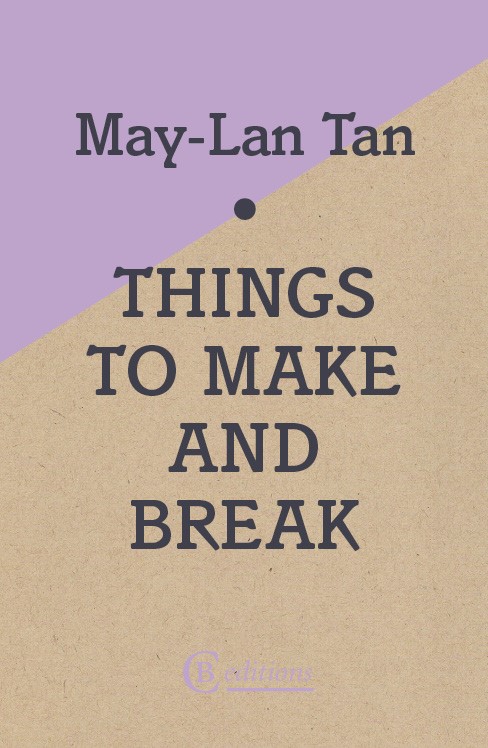CB editions
216 pages, £8.99
Reviewed by Christopher Allen
May-Lan Tan’s Things to Make and Break is all about sex—or is it? What is sex but the search for the right connection? Sometimes people get it right; more often they—we—cross lines and break rules. We break things.
Tan’s treatment of intimacy in this collection of graciously detailed short stories embraces a variety of sexual experience: from sexual abuse to attempted sexual healing, from sadomasochism to a teenager’s first flushes of jealousy. Tan doesn’t limit herself to one gender perspective or one sexual orientation. Things to Make and Break is omnisexual, and it’s mind-blowingly good.
The happy couple—the settled, gentle-in-love type—are marginalized in these pages, but they’d also feel out of place here among this crew. If the adult characters in this collection were all at the same party, many of them would be dressed in black, all would be young, fit, intelligent and experienced. You’d have questions about their tattoos and their scars. And if you’d never felt sexually disoriented yourself, you’d be quite unprepared for their stories. Maybe you’d be shocked. Maybe you’d squirm a bit. Maybe you’d feel as if you’d walked onto the wrong movie set. And this is precisely the reason you should stay awhile.
In the screenplay/narrative hybrid “Glass Candy,” Tan employs the screenplay format for off-screen scenes to enforce the nothing-is-what-it-seems theme in a story where actors depend on stunt doubles, candy glass and above all the illusion of “normal” sexuality. “Glass Candy” ends unhappily with the narrator’s conceit of the happy couple: DC, the narrator’s transsexual stunt double, chooses a gentle-in-love life with a nice guy somewhere in middle America over her Hollywood life. She chooses to “act” normal; she also chooses to keep her sexuality secret from her husband. But this is merely the narrator’s musing—an illusion. A tragic fantasy:
I picture her living in a two-story duplex, sugar maples growing in a shared front yard heaped in gold light and red leaves. In her town, people leave their doors unlocked . . . . I imagine a slightly overweight divorcé with soft, fat fingers and pretty eyes, who teaches science at the high school . . . . He washes his car every Sunday, and his favourite expression is What the hey.
Tan’s poke at normalcy? I’d like to believe this, and I think I’m pretty safe here. Tan’s collection may seem to be about broken people, but these characters are no more damaged, abused or tainted than any of us. They are us, and they’re not doing anything we’re not doing. We are all just trying to find what works. Aren’t we? I am.
Even if you come to this collection with an underdeveloped libido, you’ll still have to appreciate the art going on at the sentence- and word-levels of Tan’s prose, which is as much about language as it is about sex:
Language, as she deployed it, was neither a line cast nor a bullet fired. It was a catholic mechanism: the sharp twist of a pilot biscuit into the waifish body of Christ. A word, placed on her tongue, became flesh. One night it was almost morning, I could almost see her, every sentence a necklace she was pulling out of her mouth, tangled in smoke.
Tan’s narrator in “Julia K” is speaking about Julia of course, but he could also be speaking about Tan and Tan’s adventuresome relationship to language. Things to Make and Break is one of those books that people deface with exclamation points and stars and Wows.
And finally a word about the children. Not all the kids in the collection are broken, but they are all living in the shadow of their parents’ (sex) lives. The most drastic example of this is the story “Laurens” a two-parter about a boy and girl, both named Lauren and each manoeuvring his/her father’s violence, his brokenness. The girl Lauren seems to have more control, knows how to use a gun, could use it if she decides to (and maybe she does?); the boy Lauren is powerless, isn’t able to avoid his father’s drunken fury, although he is able to drive away from it. The point is clear enough: children are ultimately the audience to their parents’ adult films.
The breaking begins early.
***
Christopher Allen is the author of Conversations with S. Teri O’Type (a Satire). Allen’s award-winning fiction and non-fiction have appeared or are forthcoming in Indiana Review, Quiddity, SmokeLong Quarterly’s Best of the First Ten Years anthology, Prime Number Magazine, Connotation Press and Camroc Press Review, among many others. He lives in Germany.
![[PANK]](https://pankmagazine.com/wp-content/themes/pank/assets/images/pank-logo-large.png)

